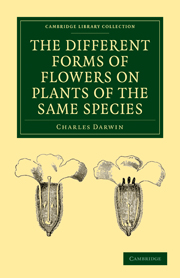Book contents
- Frontmatter
- Contents
- INTRODUCTION
- CHAPTER I HETEROSTYLED DIMORPHIC PLANTS: PRIMTULACEÆ
- CHAPTER II HYBRID PRIMULAS
- CHAPTER III HETEROSTYLED DIMORPHIC PLANTS–continued.
- CHAPTER IV HETEROSTYLED TRIMORPHIC PLANTS
- CHAPTER V ILLEGITIMATE OFFSPRING OF HETEROSTYLED PLANTS
- CHAPTER VI CONCLUDING REMARKS ON HETEROSTYLED PLANTS
- CHAPTER VII POLYGAMOUS, DIŒCTOUS, AND GYNO-DIŒCIOUS PLANTS
- CHAPTER VIII CLEISTOGAMIO FLOWERS
- INDEX
CHAPTER VII - POLYGAMOUS, DIŒCTOUS, AND GYNO-DIŒCIOUS PLANTS
Published online by Cambridge University Press: 05 July 2011
- Frontmatter
- Contents
- INTRODUCTION
- CHAPTER I HETEROSTYLED DIMORPHIC PLANTS: PRIMTULACEÆ
- CHAPTER II HYBRID PRIMULAS
- CHAPTER III HETEROSTYLED DIMORPHIC PLANTS–continued.
- CHAPTER IV HETEROSTYLED TRIMORPHIC PLANTS
- CHAPTER V ILLEGITIMATE OFFSPRING OF HETEROSTYLED PLANTS
- CHAPTER VI CONCLUDING REMARKS ON HETEROSTYLED PLANTS
- CHAPTER VII POLYGAMOUS, DIŒCTOUS, AND GYNO-DIŒCIOUS PLANTS
- CHAPTER VIII CLEISTOGAMIO FLOWERS
- INDEX
Summary
There are several groups of plants in which all the species are diœcious, and these exhibit no rudiments in the one sex of the organs proper to the other. About the origin of such plants nothing is known. It is possible that they may be descended from ancient lowly organised forms, which had from the first their sexes separated; so that they have never existed as hermaphrodites. There are, however, many other groups of species and single ones, which from being allied on all sides to hermaphrodites, and from exhibiting in the female flowers plain rudiments of male organs, and conversely in the male flowers rudiments of female organs, we may feel sure are descended from plants which formerly had the two sexes combined in the same flower. It is a curious and obscure problem how and why such hermaphrodites have been rendered bisexual.
If in some individuals of a species the stamens alone were to abort, females and hermaphrodites would be left existing, of which many instances occur; and if the female organs of the hermaphrodite were afterwards to abort, the result would be a diœcious plant. Conversely, if we imagine the female organs alone to abort in some individuals, males and hermaphrodites would be left; and the hermaphrodites might afterwards be converted into females.
In other cases, as in that of the common Ash-tree mentioned in the Introduction, the stamens are rudimentary in some individuals, the pistils in others, others again remaining as hermaphrodites.
- Type
- Chapter
- Information
- The Different Forms of Flowers on Plants of the Same Species , pp. 278 - 309Publisher: Cambridge University PressPrint publication year: 2010First published in: 1877
- 1
- Cited by



